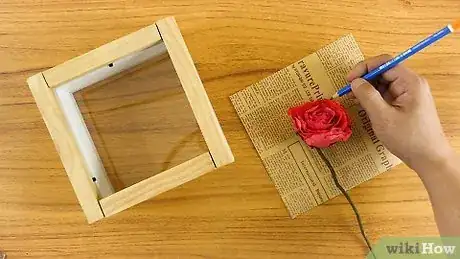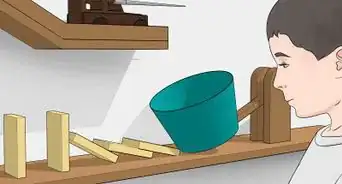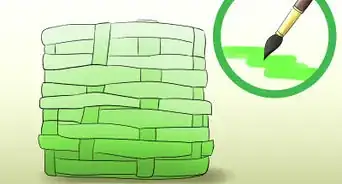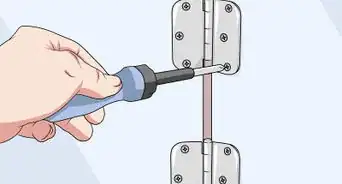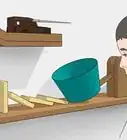wikiHow is a “wiki,” similar to Wikipedia, which means that many of our articles are co-written by multiple authors. To create this article, 18 people, some anonymous, worked to edit and improve it over time.
The wikiHow Video Team also followed the article's instructions and verified that they work.
This article has been viewed 254,132 times.
Learn more...
A shadow box is a craft device akin to a "deep frame" that is used for displaying three dimensional images or items. The craft probably originated centuries ago, whenever leisure time allowed for the assemblage of mementos. It was also used for sailors and army personnel to display their badges, medals and other service reminders.[1] The beauty of using a shadow box to display items is that it looks neat and finished when hung on a wall or placed on a shelf.
Note: This tutorial is for making a shadow box from an existing frame. For instructions on making a shadow box from scratch (from wooden sides), see further How to make a shadow box frame.
Steps
Preparing to Build the Shadow Box
-
1Gather your supplies. You’ll first need a deep or wide edged wooden picture frame. You can get these from the dollar or thrift stores for next-to-nothing. Your other supplies will be Balsa wood, a ruler, double-sided tape, a pencil, paint or something to mark the wood with, a craft knife, craft glue, and backing paper. Backing paper can just be your standard drawing paper. [2]
-
2Decide what you'd like to place inside the shadow box first. The contents will determine the size and shape of the shadow box you end up putting together. You can put whatever you want in there as long as it fits!Advertisement
-
3Consider the typical shadow box contents. Many people use seaside objects such as shells, coral, pebbles. Some people make entire doll house/storefront/miniature scenes within shadow boxes. Others prefer nature objects: gumnuts, leaves, herbs, flowers, seeds, pods, etc. Take a look at other potential options below.
- Collectibles: Stamps, spoons, coins, stickers, etc.
- Scrapbooking: The shadow box provides an great display case for scrapbook elements of all kinds.
- Insects: Do you have a butterfly or beetle collection? A shadowbox is perfect for displaying them. Be kind to the wildlife though; a paper or photographic collection can be just as interesting
- Militaria: Medals, insignia, buckles, awards, badges, etc.
-
4Arrange the objects you plan to put in the shadow box around a sheet of paper. Play around with a design in advance. That way you'll know where to glue everything in place. Arrange the actual objects on a sheet of paper about the same size as the inside of the frame, or draw the outline of the object onto blank paper to guide your arrangement later.
-
5Choose a frame that has deep sides. [3] If it doesn't have deep sides already, it won't work well for the purposes of this box. You can buy a shadowbox frame on the Internet or an arts and crafts store. You can even make your own if you want. It’s really just a picture frame.
Making the Shadow Box Backing Rest
-
1Remove any wadding or packaging from the picture frame. This will usually be cardboard or press board that sits between the image and the backing. Remove the backing but don’t discard it – you’ll use it shortly. You can discard any clips or holders on it.
-
2Make the backing rest. The backing will sit at the back of the frame, resting on four pieces of inserted balsa wood. Start by measuring the edges of your picture frame. Now use these measurements to mark and measure out four pieces of the balsa wood. They should fit inside the inner edge of the frame, about 3mm/ 1⁄8 inch (0.3 cm) shallower than the frame sides. [4]
-
3Cut the balsa wood. When cutting, make sure the balsa lengths are the same length as the frame. Make the width lengths slightly shorter, as they need to slip inside the two other longer lengths. Trust your measurements. [5]
-
4Attach the balsa pieces to the frame. Use the double-sided tape to attach the balsa pieces to the frame so that it will fit snugly in place. The longer pieces should be attached first.Then slip in the width pieces.
Adding the Backing Paper
-
1Cut out the backing paper piece. Measure so it fits inside the frame. Remember that the frame is now slightly smaller due to the addition of the balsa pieces. Use this measurement to correctly calculate the size of the backing paper, then cut the paper to the correct size.
-
2Make sure that your backing paper can fit all your objects. This is why it is important to plan ahead of time. Try lightly tracing the objects you plan to put on the paper in pencil so you can see how the layout works. Don’t go too close to the edges of the paper or you’ll bump into the frame. [6]
-
3Glue the backing paper to the back of the frame. Use a craft glue or a spray adhesive to attach the paper to the backing. Don’t use too much glue or you might make the paper wet and sticky.
Creating the Shadow Box Display
-
1Follow your design plan for adding the objects to the backing. It’s probably helpful to make small markers so you remember where each item was supposed to go. You can either glue or pin items on.
-
2Attach your objects to the backing. If you’re using glue make sure you allow the glue to dry before restoring the backing to the frame. If you are pinning your items to the backing you might need to add a thin sheet of foam to the backing before gluing the backing paper in place, so that the pins have something to stick into.
-
3Add any labels, decorative items or border lace/ribbon. This is optional but may fit with the theme of your shadow box. Try to have fun with it. You want the shadowbox to look nice, and now is your chance to add any additional decoration.
Fitting the Backing Into the Shadow Box
-
1Place the backing in the frame. Carefully shift the backing into place inside the frame. Rest it on the pre-affixed balsa wood pieces. Make any adjustments needed so that it sits flat. [7]
-
2Fix the backing firmly to the frame. Use a strong tape, such as framer's tape, brown packing tape, or duct tape. The tape must be able to hold the frame in place long-term. Put enough on to keep it sturdy without ruining the aesthetic of the shadowbox. [8]
-
3Hang your shadowbox. Remember, if you are hanging your shadowbox you may need to attach a hanging device at this point, unless one is already in place. Put a nail or a hanging pin into the wall. If there is a portion of the frame hanging open because you've removed clips or holders, tape this section shut too.
-
4Enjoy your shadowbox. Once you’ve placed your shadowbox in its display area you can sit back and appreciate your accomplishment. You can hang, lean or stand the frame up, depending on the type of frame used.
Community Q&A
-
QuestionCan I use picture frame glass to put on the top?
 Ashton GilmoreCommunity AnswerYes, the glass would just have to be the correct size. You could also use pieces of acrylic or Plexiglas.
Ashton GilmoreCommunity AnswerYes, the glass would just have to be the correct size. You could also use pieces of acrylic or Plexiglas.
References
- ↑ http://en.wikipedia.org/wiki/Shadow_box
- ↑ https://www.crateandbarrel.com/blog/diy-shadow-box/
- ↑ https://www.crateandbarrel.com/blog/diy-shadow-box/
- ↑ https://www.crateandbarrel.com/blog/diy-shadow-box/
- ↑ https://www.crateandbarrel.com/blog/diy-shadow-box/
- ↑ https://www.crateandbarrel.com/blog/diy-shadow-box/
- ↑ https://www.crateandbarrel.com/blog/diy-shadow-box/
- ↑ https://www.crateandbarrel.com/blog/diy-shadow-box/
About This Article
To make a shadow box, start by removing the backing from a deep wooden picture frame, and attaching pieces of balsa wood onto the back to give it more depth. Next, measure out a thick piece of paper big enough to fit the back of the frame. Then, glue your objects onto the paper, making sure not to go too close to the edges to avoid bumping into the frame. Finally, glue the paper over the balsa wood pieces to display your objects inside the box, and add any decorations like labels or ribbons if you like. To learn more, including how to use shadow boxes to display collectible items like stamps and coins, read on.





